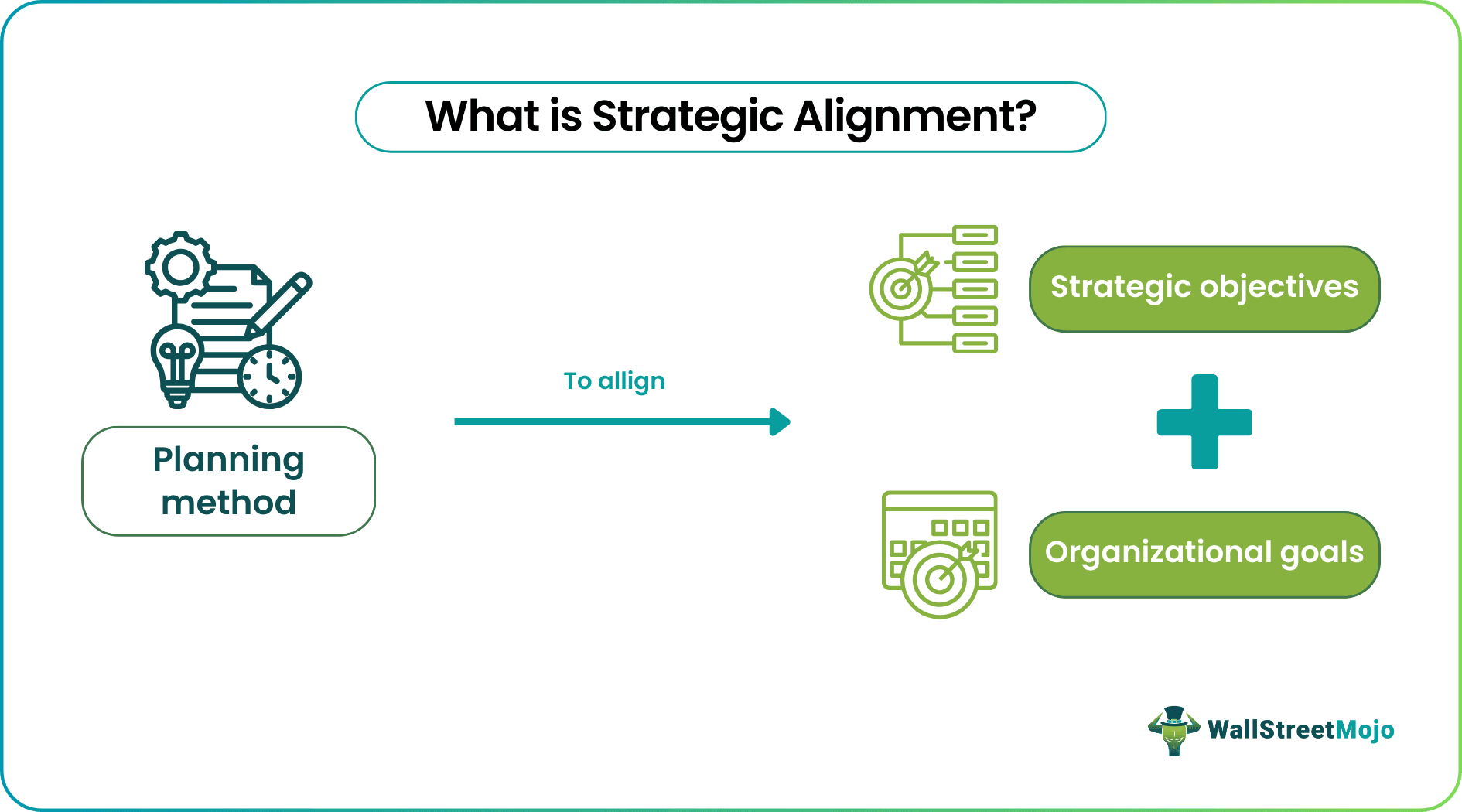Table Of Contents
Strategic Alignment Meaning
Strategic Alignment refers to the method of planning and executing a set of actions to help an organization’s strategies align with its primary objective. It aims to streamline the internal and external factors on which to focus and commit to achieve the organization’s vision to remain sustainable and profitable.

It forms an essential element of positioning development and is a significant business asset. It assists businesses in being competitive in the dynamic and transforming global business environment through enhanced workforce performance.
Key Takeaways
- Strategic alignment is the process of organizing and driving a series of steps to support a business’s strategy in alignment with its primary goal.
- It serves to emphasize the alignment and binding of external and internal stakeholders with the firm’s common goal so as to maintain sustainability and profitability.
- It can be achieved in an organization by the following steps - understanding goals, arranging and distributing objectives,
- encouraging staff participation, defining employee roles, linking company goals and staff performance, and creating metrics to measure success.
- It is essential because it helps with organizational unity, resource utilization, accurate reports, improved planning, and adjustments.
Strategic Alignment Explained
Strategic alignment definition states it as a fundamental business concept that estimates the competitiveness of a company so as to help it grow and profit during the most challenging economic scenarios and chaotic markets. It is a procedure for linking the culture, resources, and structure of an organization with its strategy. Thus, it means integrating all aspects into an efficient plan that supports strategic goals holistically. However, it can succeed if there is sufficient awareness of the broader environment, technological change, and regulatory issues.
It has positive and significant implications for a firm, resulting in better work quality, efficiency, and team motivation. It also promotes making informed choices, carrying on long-term and bottom-line benefits, and that too without any sunken costs.
In the field of finance, the strategic alignment model and organizational strategic alignment are vital to companies during the process of mergers and acquisitions (M&A). Any successful M&A transaction depends highly on the proper alignment of the direction, objectives, and goals of the targeted and acquiring companies. It is because strategic alignment is crucial for unlocking synergies, creating a unified vision, and maximizing benefits.
Examples
Let us understand the topic more clearly using a few examples.
Example #1
The importance of strategic alignment amongst B2B marketers has been highlighted in an online article published on April 17, 2023. It states that B2B marketers have realized the importance of mature conversations and shared goals to develop healthy sales relationships instead of using them just as tools to drive leads. It is known that marketing and sales have a very close working relationship full of growth opportunities yet full of tense moments with high accountability and priorities.
Moreover, a recent report has underscored the non-alignment of sales and marketing to the level where 50% of B2B sales associates still need to achieve their goals. Hence, their alignment with each other caters to an evolving buying cycle while shortening the sales funnel, leading to the expansion of their influence and increased sales growth. For this purpose, the sales and marketing team must build a strategy using education, expertise, and alignment. As a result, it will train sales representatives and create marketing materials that impact client relationships beyond the sales team.
Example #2
Suppose Alex is the marketing and sales head of a shoe company. The company has launched a new product that targets teenagers. To market the product effectively, Alex aligns organizational strategies, employs marketing techniques, and guides the sales team in utilizing tools to close deals.
The marketing team created campaigns to generate interest and awareness, while the sales team communicated key features and benefits to prospects. This strategic alignment helped ensure that resources are used efficiently to achieve a common organizational goal.
How To Achieve?
For achieving strategic alignment within an organization, the following roadmap should be followed:
- Understanding Goals: First, try to collect and review all documentation related to the company’s vision, mission, goals, and strategy. Then, get input from company leaders to make necessary amends and ensure accuracy.
- Arrange And Distribute Objectives: Consolidate company goals in a document and distribute them to employees via print, verbal, or electronic media.
- Encourage Staff Participation: Next, try to seek ideas and feedback from staff because their input may add to new activities or techniques that align with business goals.
- Define Employee Roles: Now, carefully study the employee feedback to define and assign roles, including tasks, and to align them with company objectives and optimize individual expertise and skills for maximum impact.
- Link Company Goals And Staff Performance: Towards the end, emphasize to employees that their performance has a direct impact on the overall achievement of the company’s goals.
- Create Metrics To Measure Success: Finally, the progress made must be tracked by the proper implementation of regular reporting procedures. And as per the outcomes, make appropriate adjustments to improve the incident strategic alignment process.
Importance
For businesses, it is because it offers multiple benefits, as follows:
- Organizational Unity: When company staff collaborate to achieve common goals, their efficiency, satisfaction, and connection improve.
- Resource Utilization: Employees start working to make their practices and priorities in line with company strategies. It leads to informed decision-making, efficient time management, and resource utilization.
- Accurate Reports: Continuous monitoring, status updates, and the generation of progress reports lead to the extraction of accurate information. This in turn, helps in timely guidance, adjustments, and decision-making in the organization.
- Improved Planning: For a better understanding of company goals, employees prioritize deliverables, steps, and practices for long-term success.
- Make Adjustments: Companies adapt to market dynamics by sustaining productivity and efficacy in response to evolving demands.
